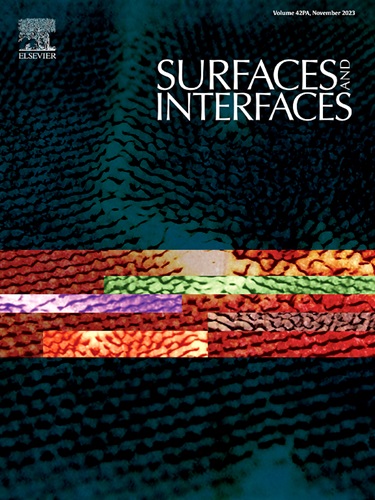Plasma functionalization and etching of ABS substrates for enhanced adhesion of decorative ZrN coatings
IF 5.7
2区 材料科学
Q2 CHEMISTRY, PHYSICAL
引用次数: 0
Abstract
Zirconium nitride (ZrN) coatings were deposited onto etched acrylonitrile butadiene styrene (ABS) substrates using low-temperature direct current reactive magnetron sputtering. Plasma etching was employed to modify the substrate's surface reactivity, surface roughness, and hydrophilicity, achieving a high total surface free energy up to 50.2 mN/m, which is essential for strong ZrN coatings adhesion. X-ray diffraction analysis revealed a predominant [111] texture in the ZrN coatings across ABS substrates treated with varying plasma etching times. Interestingly, etching for 5 minutes at 1.5 Pa pressure produced a [200] texture. Varying the etching time from 2 to 8 minutes at a pressure of 0.4 Pa led to the enlargement of height and width of surface feature tops, while etching at 5 minutes and 1.5 Pa resulted in a smaller grain size and a smoother coating surface. ZrN coatings deposited on ABS substrates etched for 5 minutes at 0.4 Pa displayed a golden hue with high lightness (L* ≈ 74%) and a total reflectance of 62% at a thickness of 750 nm. In contrast, increasing the plasma etching pressure to 1.5 Pa led to glossy ZrN coatings with minimal pinholes, though the increased pressure slightly reduced total reflectance due to cracking, associated to compressive stresses. Peel adhesion tests confirmed robust bonding of all ZrN coatings to the ABS substrates. These findings emphasize the key role of plasma etching in enhancing both the adhesion strength and the visual appeal of ZrN coatings on ABS substrates. By optimizing etching parameters, it is possible to achieve coatings with superior aesthetic qualities, such as a desirable golden tone and smooth finishes. This makes ZrN-coated ABS substrates highly promising for decorative applications in the automotive industry.

求助全文
约1分钟内获得全文
求助全文
来源期刊

Surfaces and Interfaces
Chemistry-General Chemistry
CiteScore
8.50
自引率
6.50%
发文量
753
审稿时长
35 days
期刊介绍:
The aim of the journal is to provide a respectful outlet for ''sound science'' papers in all research areas on surfaces and interfaces. We define sound science papers as papers that describe new and well-executed research, but that do not necessarily provide brand new insights or are merely a description of research results.
Surfaces and Interfaces publishes research papers in all fields of surface science which may not always find the right home on first submission to our Elsevier sister journals (Applied Surface, Surface and Coatings Technology, Thin Solid Films)
 求助内容:
求助内容: 应助结果提醒方式:
应助结果提醒方式:


